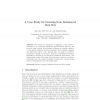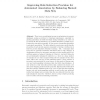25 search results - page 2 / 5 » Learning to Predict Salient Regions from Disjoint and Skewed... |
AI
2001
Springer
13 years 9 months ago
2001
Springer
We present our experience in applying a rule induction technique to an extremely imbalanced pharmaceutical data set. We focus on using a variety of performance measures to evaluate...
INFFUS
2008
13 years 4 months ago
2008
act 11 We describe an ensemble approach to learning from arbitrarily partitioned data. The partitioning comes from the distributed process12 ing requirements of a large scale simul...
KELSI
2004
Springer
13 years 10 months ago
2004
Springer
There is an overwhelming increase in submissions to genomic databases, posing a problem for database maintenance, especially regarding annotation of fields left blank during submi...
DCC
2008
IEEE
14 years 4 months ago
2008
IEEE
A fully automated architecture for object-based region of interest (ROI) detection is proposed. ROI's are defined as regions containing user defined objects of interest, and ...
BMCBI
2004
13 years 4 months ago
2004
Background: In addition to known protein-coding genes, large amounts of apparently non-coding sequence are conserved between the human and mouse genomes. It seems reasonable to as...


